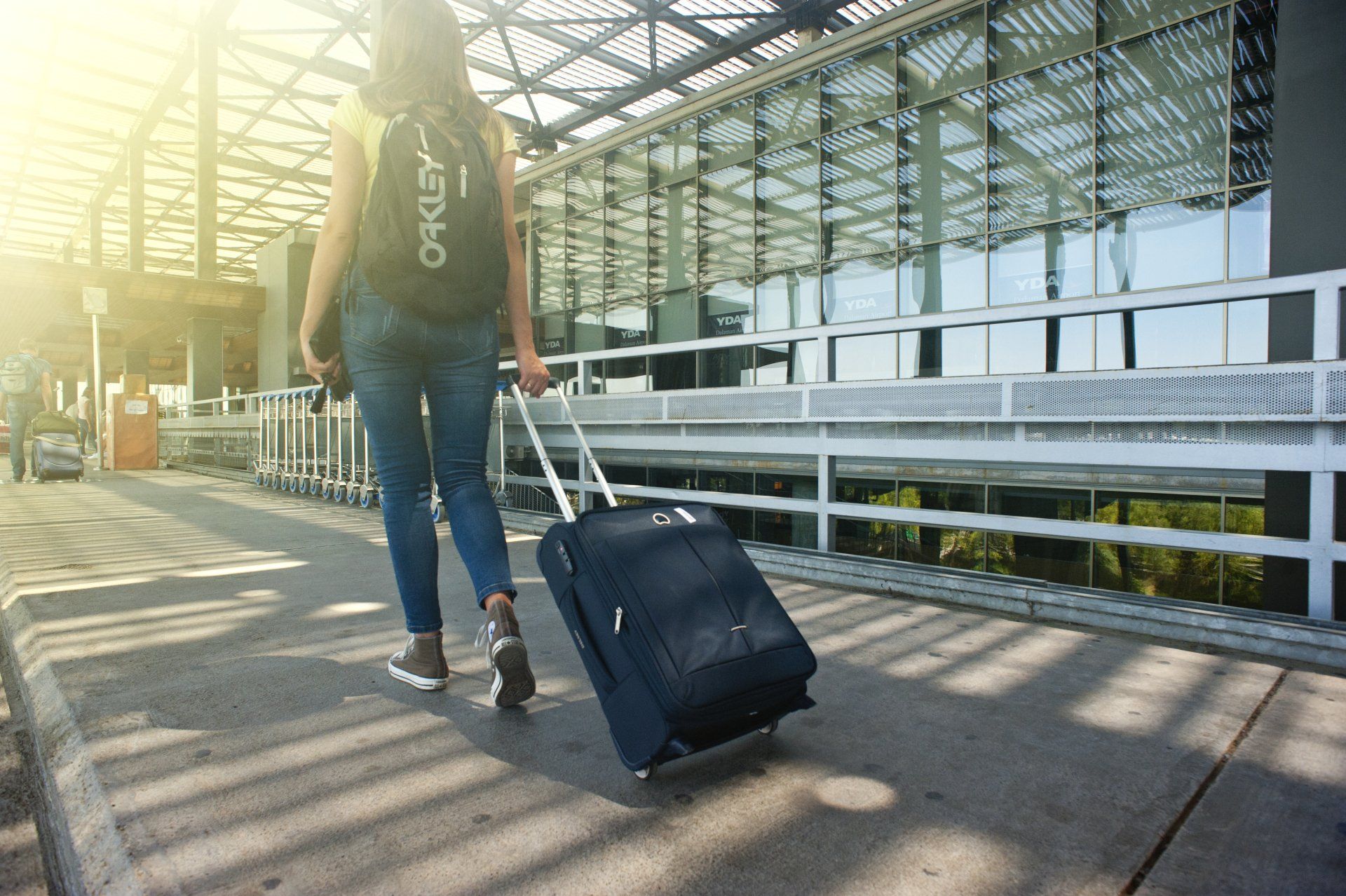Options when there is a ground stop.
John Holden • June 28, 2023
All is not lost if there is a ground stop.

When flights are grounded due to a ground stop, travelers may be left wondering what their transportation options are. With the right knowledge and preparation, travelers can make the most of these unexpected delays. Here are a few ideas for a blog post on transportation options when there is a ground stop for the airlines.
- Consider other airports: If your flight is grounded at one airport, it may be possible to find another nearby airport that isn’t affected by the ground stop. It’s important to check with your airline or travel agent before making any decisions as some airports may have different rules and regulations than others.
- Look into alternate modes of transportation: Depending on where you’re located, there may be other forms of transportation available such as buses, trains, or rental cars. These can often be more cost-effective than flying and provide an alternative way to get to your destination.
- Take advantage of hotel deals: Many hotels offer discounted rates for travelers who have been affected by flight delays or cancellations due to a ground stop. It’s worth looking into these deals if you need somewhere to stay while you wait for your flight to resume operations.
- Make the most of your time: A ground stop doesn’t have to mean wasted time! While waiting for your flight, take advantage of local attractions and activities in the area or explore new places you haven't seen before.
By following these tips, travelers can make the most out of unexpected delays caused by a ground stop and ensure you get to your destination safely and efficiently!

Imagine stepping outside and being met with dangerously high temperatures that make the air feel heavy and unbearable. For millions of people worldwide, this feeling is no longer rare. Record-breaking heat waves are sweeping the globe, setting new temperature highs and reshaping daily life as we know it. But why is this happening, how is it affecting us, and most importantly, what can we do? Let's unpack the reality of record-setting heat waves and their profound implications.

In recent years, ridesharing services like Uber and Lyft have revolutionized the transportation landscape, offering convenience and flexibility that traditional taxi services struggled to match. However, as these services have grown exponentially, so too have the regulatory challenges they present. Among these is the controversial preemption clause in Utah's rideshare legislation, which raises questions about public safety and local governance. Understanding the Preemption Clause The preemption clause in Utah's rideshare law effectively prevents local governments from enforcing their transportation regulations on rideshare companies. This clause is intended to create a uniform regulatory framework across the state, simplifying compliance for companies like Uber and Lyft. However, it also strips local authorities of their ability to implement oversight tailored to their community's specific needs. The Hazards of Limited Oversight Without local oversight, rideshare drivers have been increasingly reported for soliciting customers of the official app at events, bypassing the checks and balances that the apps provide. This undermines the transparency and accountability that form the backbone of consumer trust and poses significant public safety risks. When rides are conducted off the app, there's less accountability, no digital trail, and often no insurance coverage, which could leave passengers vulnerable in an incident. Take, for example, reports from Utah where drivers have been seen offering direct services outside the app, a practice that can open the door to unregulated activity. While some argue this behavior stems from drivers seeking fairer compensation, balancing innovation with public safety is crucial. The Impact on Drivers and Riders For drivers, the preemption clause presents a double-edged sword. On one hand, it allows for more freedom and a more extensive customer base. On the other, it exposes them to potential liability issues and diminishes their protection under the rideshare company’s umbrella. Riders, meanwhile, might unwittingly jeopardize their safety by accepting rides outside the official platform—a decision that could have dire consequences. Arguments For and Against the Preemption Clause Supporters of the preemption clause argue that it spurs innovation by providing a consistent regulatory environment, making it easier for rideshare companies to operate and expand. They believe this uniformity is crucial to maintaining these services' economic benefits. However, opponents highlight the loss of local control as a significant downside, arguing that it hampers municipalities' ability to enact rules that protect their residents. Striking a Balance What’s the solution? We need to strike a balance between fostering innovation and ensuring public safety. Policymakers and stakeholders must revisit rideshare regulations, focusing on protecting the public while still allowing the industry to thrive. A collaborative approach involving both state and local authorities can help establish a regulatory framework that accommodates each community's unique dynamics. Call to Action It's time for policymakers, stakeholders, and the public to engage in meaningful dialogue about rideshare services' place in our communities. We must demand a balanced approach that doesn't sacrifice safety for the sake of convenience. Encourage your local representatives to consider the implications of preemption clauses and advocate for regulations that prioritize innovation and public welfare. Join the conversation. Share your thoughts and experiences with ridesharing in your community. Together, we can ensure these services enhance our lives without compromising safety and trust.

Introduction Have you ever wondered if the gig economy has historical parallels? One striking comparison is between the modern rideshare industry and the historical concept of sharecropping. While these systems have been separated for over a century, their similarities in labor arrangements and economic exploitation are worth exploring. What Was Sharecropping? Historical Context Sharecropping emerged in the Southern United States after the Civil War, filling the void left by the abolition of slavery. Former slaves and poor whites had few options but to lease land from wealthy landowners. In return, they would pay a share of their crops as rent. How It Worked The arrangement seemed straightforward but was fraught with inequality. Landowners held significant control over the sharecroppers, dictating terms that often kept them in cycles of debt. This lack of economic freedom perpetuated poverty and widened racial inequalities. The Modern Rideshare Model Fast forward to today, and we see a similar narrative unfolding in the rideshare industry dominated by companies like Uber and Lyft. Here’s how: Unequal Power Dynamics Just like the landowners of the past, rideshare companies wield considerable control over their drivers. They set the rates, determine working conditions, and have the final say in employment terms. Drivers, much like sharecroppers, have little to no say in these critical aspects of their work. Lack of Job Security and Benefits Both sharecroppers and rideshare drivers face a lack of job security and benefits. Sharecroppers had no financial safety nets and were often at the mercy of the landowner’s whims. Similarly, rideshare drivers are classified as independent contractors, making them ineligible for benefits like healthcare, paid leave, or retirement plans. The Role of Technology Perpetuating Labor Models Technology now plays a pivotal role in perpetuating these labor models. The algorithms used by rideshare companies dictate when and where drivers should work. While this promises flexibility, the reality is often a lack of control over one's work schedule and income. Increasing Corporate Control Advanced technology also enables rideshare companies to monitor driver performance incessantly, like landowners who closely monitor their sharecroppers. This constant surveillance can increase stress and further tilt the balance of power in favor of the corporation. Economic Impact on Workers Debt and Poverty Cycles Both systems trap workers in cycles of debt and poverty. Sharecroppers often owe more to the landowner than their share of the crop can cover, leading to perpetual debt. Similarly, rideshare drivers bear car maintenance costs, fuel, and insurance, often finding their earnings insufficient to cover these expenses. Potential Solutions To break these cycles, we need meaningful changes. Here are some suggestions: Policy Changes: Implement laws that provide gig workers with essential benefits and protections. Unionization: Support efforts to unionize rideshare drivers, giving them a collective voice to negotiate better terms. Technological Fairness: Promote transparency in the algorithms that dictate gig work, ensuring they serve the workers and the company's interests. Conclusion Recognizing the parallels between sharecropping and the modern rideshare industry is crucial for addressing today's economic exploitation. By understanding these dynamics, we can work towards creating a fairer, more equitable system for all. Ready to take action? Engage with local labor rights organizations and support policies that protect gig workers. Let's strive for a future without economic exploitation.

The Gig Economy's Impact Over the Last Decade The gig economy has revolutionized our lives in the past ten years. These changes have become our new normal, from Uber rides and electric scooters to Airbnb listings. Most of us have probably participated in at least one of these services, enjoying improved travel, accommodation, and customer service experiences. The convenience and cost savings are undeniable. Historical Context and Modern Relevance The gig economy isn't a 21st-century invention. Before the Industrial Revolution, people engaged in gig-like work through farming, transportation, and sharecropping. Today's gig economy mirrors those earlier forms of employment, emphasizing flexibility and short-term engagements. Interestingly, the 40-hour workweek is a relatively recent development. Yet, we're now seeing a shift back to gig work. This shift raises questions about job stability and employee conditions in modern society. How does this trend impact the American economy, people, and government? By examining the past, we can uncover gig work's benefits, challenges, and consequences. The Shift Back to Gig Work During the agricultural and industrial revolutions, skilled labor was essential. Businesses and governments invested heavily in science and research, believing it would bring power and achieve cherished goals. Today, the rise of the gig economy is primarily driven by venture capital (VC) funding. The tech boom of the 1990s led VCs to invest in companies with rapid growth potential, aiming to achieve profitability later. Amidst this tech growth, the 2008 recession hit, leading to new economic concepts. Millennials entered the workforce, prioritizing experiences over ownership. This created a surge in demand for gig work, while supply grew as people sought supplemental income with minimal investment. Venture Capitalists and Their Impact Venture capitalists have played a pivotal role in the gig economy's expansion. Platforms like Airbnb, Uber, and Lyft disrupted traditional industries, creating new "unicorns." While consumers benefit from competitive prices, gig workers often struggle with low wages. Meanwhile, VCs, founders, and employees reap significant profits. What does this mean for the American middle class? Gig platforms provide additional income sources, but why do many middle- and lower-middle-class individuals find themselves taking on multiple jobs? Rising costs for essentials like healthcare and education eat into their earnings. The gig economy often relies on government subsidies for healthcare and welfare, creating a disparity between corporate profits and worker pay. The Gig Economy's Future According to the U.S. Bureau of Labor Statistics, 16.5 million people are part of the gig economy. A Future Workforce Report from Upwork shows that 59% of U.S. companies use flexible workforces. While businesses save money, gig workers face unpredictable incomes, lack of retirement benefits, and no health insurance. The gig economy is here to stay, driven by globalization, technology, and the rise of smartphones. However, gig workers lose traditional safety nets, increasing the government's burden. Raising taxes to support these workers could slow economic growth, impacting future generations. Conclusion America remains an innovator but is now facing a new kind of poverty. The middle class is shrinking, reversing the "American Dream." People struggle to reach their goals despite hard work. What should be done? Companies should focus on shareholder value while the government enforces rules to protect workers. History shows that wealth imbalances lead to societal unrest. Current economic statistics don't predict the future, and we need to address these issues now. Without stronger safety nets for gig workers, gig capitalism cannot endure. What do you think? How can we balance innovation with worker protection? Share your thoughts in the comments.










